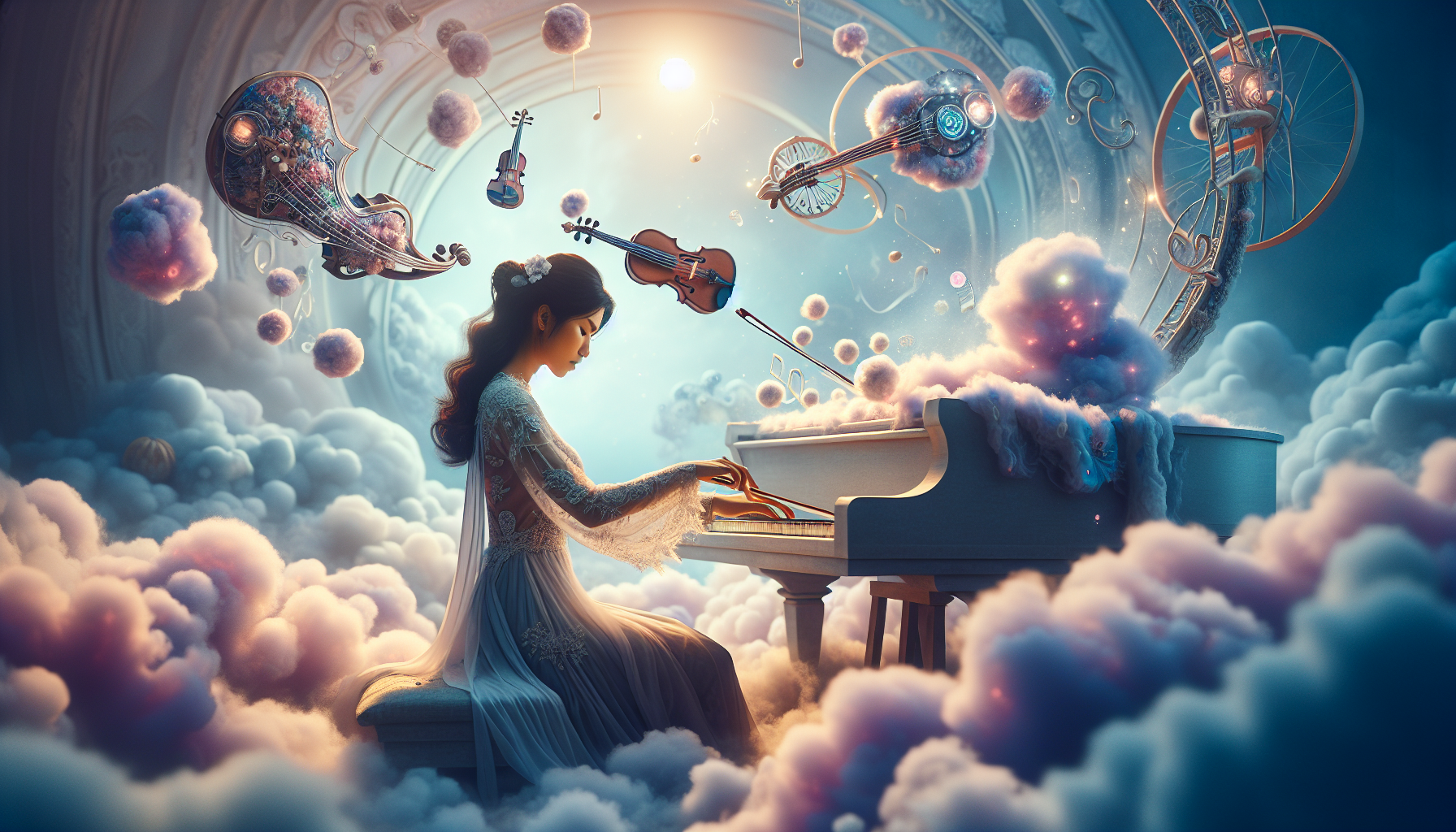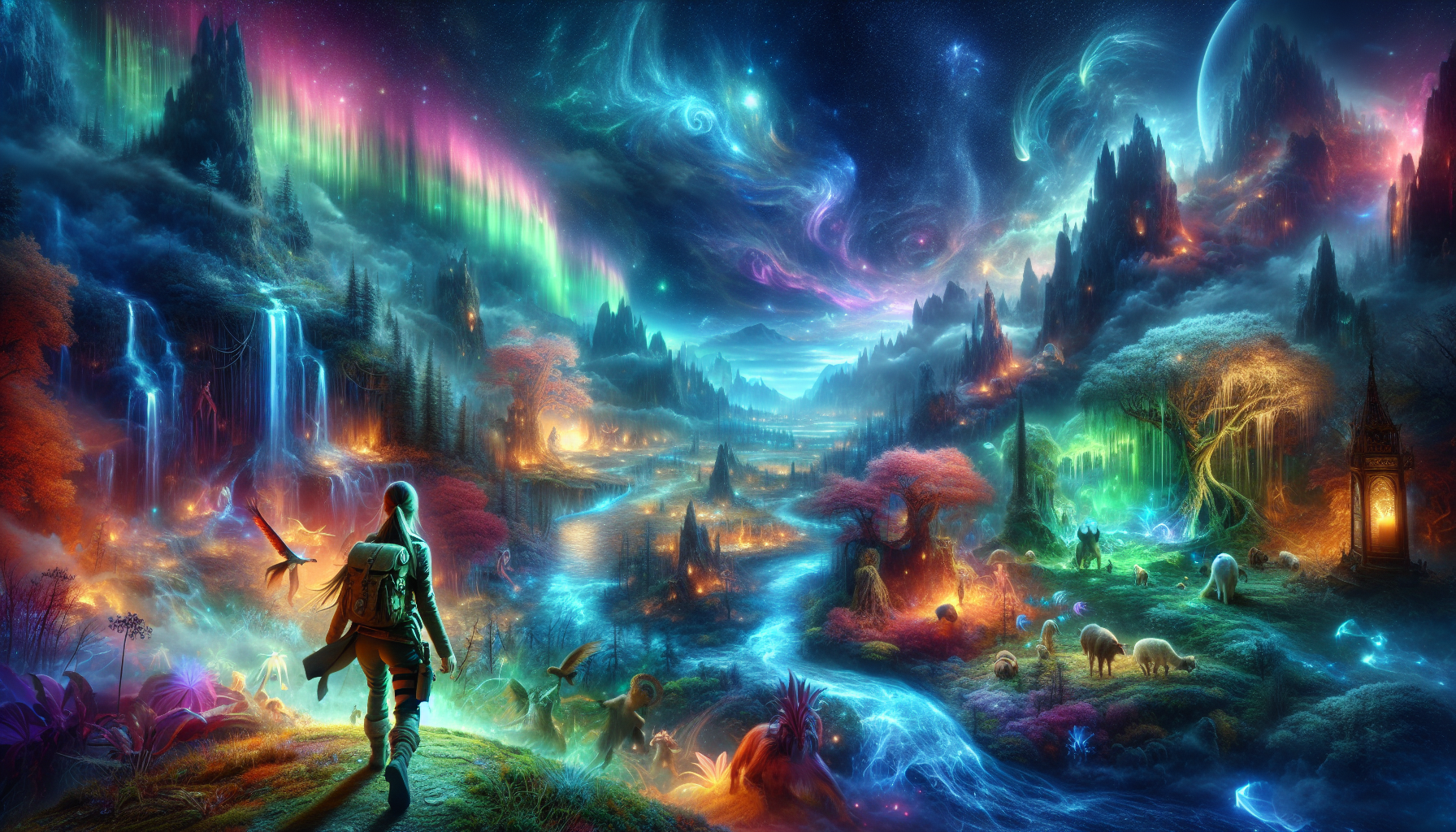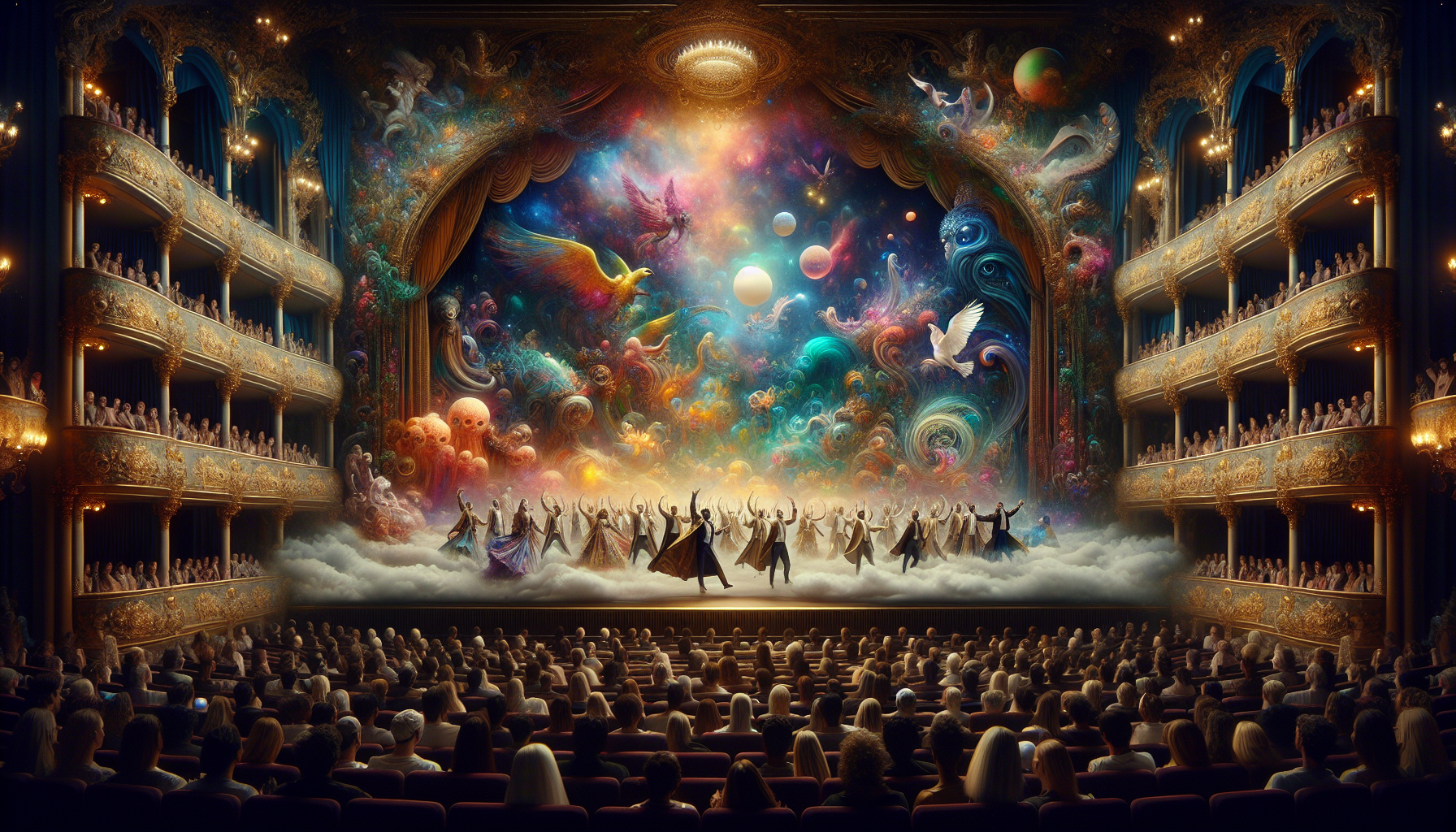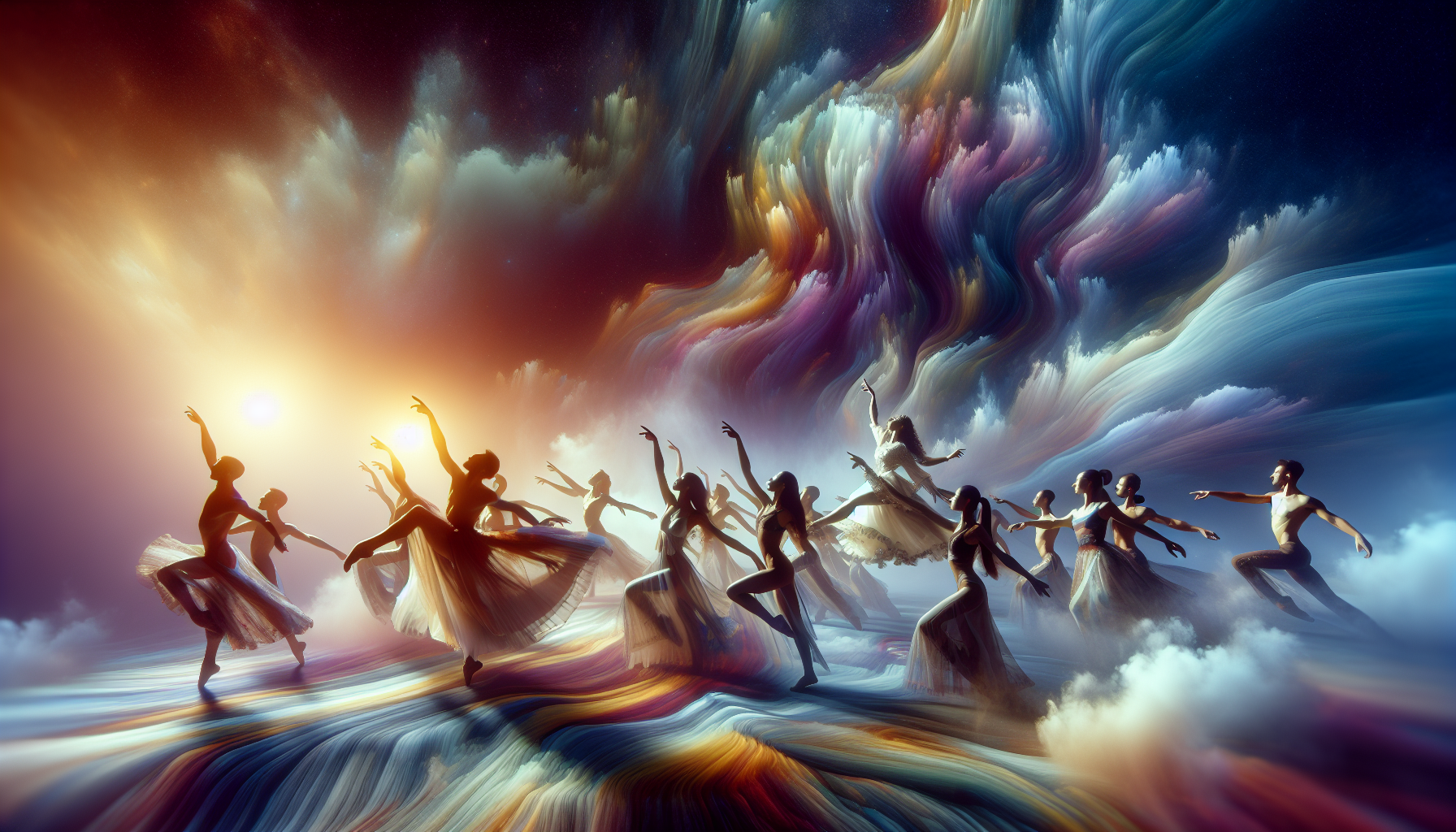In a world that never sleeps, where the cacophony of modern life often drowns out the subtle whispers of creativity, there exists a realm untouched by the constraints of reality. This is the dream realm—a mystical place where time bends, colors blend, and sounds transcend the ordinary. Imagine a space where melodies float like wisps of cloud, inviting you to weave them into tapestries of sound that resonate with the deepest parts of the human soul. Welcome to “Dreamy Melodies: Crafting Music from the Depths of the Dream Realm,” a journey into the heart of imagination where music becomes the language of dreams. 🌌
In this exploration, we delve into the mysterious intersection between dreams and music, uncovering how these two ethereal experiences intertwine to create something profoundly beautiful and deeply personal. We’ll navigate through the science of dreams and the subconscious mind, exploring how nocturnal narratives can inspire compositions that feel both hauntingly familiar and refreshingly novel. Along the way, we’ll meet composers and musicians who have harnessed the power of their dreams to craft pieces that linger in the waking world, leaving an indelible mark on listeners. Whether you’re a seasoned musician, an aspiring composer, or simply a lover of music, the insights gathered here promise to inspire and ignite your creative spark.
Our journey will cover a rich tapestry of topics, including the neuroscience behind dreaming, techniques for translating dream experiences into musical motifs, and the role of technology in capturing the fleeting nature of dreams. We’ll also explore historical perspectives, examining how legendary composers like Beethoven and Stravinsky may have drawn upon their dreams to compose masterpieces that continue to captivate us. Finally, we’ll provide practical tips for those eager to tap into their own dream realms, offering guidance on how to record, interpret, and ultimately transform these nocturnal visions into tangible, audible art. So, sit back, relax, and prepare to traverse the dreamscape, where the boundaries between sleep and wakefulness blur, and where every note holds the promise of a new discovery. 🎶
The Intricacies of Dream Music
Music has long been an integral part of human culture, acting as a bridge between the conscious and unconscious realms. The idea of crafting melodies that originate from dreams, however, is a relatively unexplored territory that offers a plethora of possibilities. Dream music, as it is sometimes called, is a genre that seeks to harness the subconscious mind’s potential to create unique and ethereal compositions. This journey into the depths of the dream realm is not just about producing sounds; it’s about understanding the mysterious processes of our minds during sleep and how they can be translated into musical expressions.
Dreams are a rich tapestry of our subconscious thoughts, emotions, and experiences. The dream realm is a space where time and logic often lose their rigidity, allowing for a fluid exploration of ideas and emotions that might be suppressed or overlooked in our waking lives. Crafting music from this realm involves a process of translating these ephemeral experiences into sound. This transformation is not only an artistic endeavor but also a scientific one, as it involves understanding the neural and psychological processes that occur during dreaming.
One of the challenges in creating dream music is capturing the essence of the dream experience. Dreams can be elusive and difficult to recall with clarity, often disappearing upon waking. Musicians and composers interested in this genre often keep dream journals to document their nocturnal experiences as soon as they wake up. This practice helps in retaining the vividness of the dream, providing a more accurate source of inspiration for their compositions. Moreover, advancements in technology, such as brainwave monitoring and sound synthesis, have begun to play a significant role in bringing dream music to life, allowing for an exploration of sounds and rhythms that mirror the complexities of our dream states.
Technology and Dream Music Creation
With the advent of technology, the process of creating music inspired by dreams has taken on new dimensions. Devices that monitor brain activity, such as EEG machines, are now being used to track the brainwave patterns during REM sleep, which is the stage most closely associated with vivid dreaming. These patterns can be translated into musical notes and compositions, providing a direct link between the subconscious mind and the music being created. This innovative approach has opened up new possibilities for musicians and composers, allowing them to access the raw, unfiltered essence of their dream experiences.
Sound synthesis technology also plays a crucial role in the creation of dream music. By utilizing software synthesizers, musicians can create unique soundscapes that reflect the surreal and often abstract nature of dreams. These tools allow for a high degree of experimentation, enabling artists to manipulate sounds in ways that would be impossible with traditional instruments. The result is a genre of music that is as diverse and unpredictable as the dreams that inspire it.
Moreover, technology has facilitated collaboration among artists across the globe, enabling them to share their dream-inspired creations and gather feedback from a wider audience. Platforms like YouTube and SoundCloud provide a space for dream musicians to showcase their work, fostering a community of like-minded individuals who are passionate about exploring the intersection of dreams and music. For a fascinating look into the creation of dream music, you can watch this video on YouTube: “Dreamscapes: Crafting Music from the Subconscious” – DreamWave Channel.
Historical Perspectives on Dream-Inspired Music
The concept of drawing inspiration from dreams is not new; it has been a source of creativity across various cultures throughout history. Ancient civilizations often regarded dreams as messages from the divine or as a window into otherworldly realms. Music inspired by dreams was seen as a way to communicate these mystical experiences to others, serving both as art and as a spiritual practice.
In the Western classical tradition, several composers have claimed that their works were inspired by dreams. For instance, composer Giuseppe Tartini famously credited a dream encounter with the devil for the creation of his “Devil’s Trill Sonata.” This piece is renowned for its technical challenges and emotional depth, which Tartini attributed to the dream’s vividness. Similarly, 19th-century composer Robert Schumann is said to have composed several pieces based on musical themes he heard in his dreams.
Beyond classical music, the surrealist movement of the early 20th century, led by figures such as Salvador Dalí and André Breton, embraced dreams as a source of artistic inspiration. This movement sought to explore the unconscious mind and its influence on creativity, a theme that resonated with musicians of the time. The integration of dream-like qualities into music became more pronounced, influencing genres such as jazz and later, psychedelic rock. These genres often featured improvisation and experimentation, reflecting the fluid and unpredictable nature of dreams.
Contemporary Explorations
In contemporary music, the exploration of dreams continues to be a vibrant source of inspiration. Artists across genres are increasingly looking to their dreams as a muse, using them to create innovative and evocative compositions. This trend is not limited to any one style of music; rather, it spans everything from ambient and electronic music to folk and indie rock. The allure of dream-inspired music lies in its ability to evoke emotions and imagery that resonate on a deeply personal level, offering listeners a glimpse into the artist’s subconscious world.
Today’s musicians have access to a wide range of tools and platforms that make it easier than ever to translate dream experiences into music. Digital audio workstations, for example, allow artists to layer sounds and create complex textures that mimic the multi-dimensional nature of dreams. Additionally, the rise of virtual reality and immersive technologies offers new ways to experience dream music, creating a multisensory experience that enhances the listener’s connection to the music.
The internet has also played a crucial role in the dissemination of dream-inspired music, providing artists with a platform to reach a global audience. Social media and streaming services enable musicians to share their work and connect with fans who share an interest in the dream realm. This has led to the emergence of a vibrant community of artists and enthusiasts who are dedicated to exploring the intersection of music and dreams. For more insights into how contemporary artists are crafting dream-inspired music, check out this engaging video: “The Art of Dream Music: A Modern Exploration” – DreamSound Collective.
Practical Tips for Creating Dream-Inspired Music
If you’re interested in venturing into the world of dream-inspired music, there are several practical steps you can take to begin your journey. The key is to approach the process with an open mind and a willingness to experiment, as dream music is inherently a fluid and exploratory genre. Here are some tips to help you get started:
- Keep a Dream Journal: Record your dreams as soon as you wake up to capture the details and emotions while they’re still fresh. This will provide you with a rich source of inspiration for your compositions.
- Experiment with Sound: Use synthesizers and digital audio workstations to experiment with different sounds and textures. Don’t be afraid to manipulate sounds in unconventional ways to reflect the surreal nature of your dreams.
- Incorporate Field Recordings: Consider incorporating field recordings into your music to add an element of realism and depth. This can help ground your compositions while still allowing for dream-like qualities.
- Collaborate with Other Artists: Connect with other musicians who share an interest in dream-inspired music. Collaboration can lead to new ideas and approaches that you might not have considered on your own.
- Share Your Work: Use online platforms to share your dream-inspired music with a wider audience. This can help you gain feedback and connect with listeners who appreciate your unique approach.
Creating dream-inspired music is a deeply personal and rewarding experience that allows you to explore the depths of your subconscious mind. By embracing the unpredictability and fluidity of dreams, you can create compositions that resonate with listeners on a profound level, offering them a glimpse into the artist’s subconscious world. For a practical demonstration of how to start composing dream-inspired music, watch this helpful tutorial: “How to Create Dream Music: A Step-by-Step Guide” – Music Dreamers Channel.
Future Directions and Innovations
The future of dream-inspired music is full of exciting possibilities, as advancements in technology and neuroscience continue to push the boundaries of what is possible. As our understanding of the brain and its processes during sleep deepens, we can expect to see even more innovative approaches to crafting music from the dream realm.
One area of potential growth is the use of artificial intelligence in the composition of dream music. AI algorithms can analyze brainwave patterns and dream journal entries to generate music that reflects the emotional and thematic elements of dreams. This approach could lead to the creation of personalized dream soundtracks that are tailored to the individual’s unique dream experiences.
Another promising avenue is the development of immersive experiences that combine dream music with virtual reality or augmented reality. These technologies have the potential to create fully immersive environments that transport listeners into the dream world, offering a multisensory experience that blurs the lines between reality and imagination.
The exploration of dreams and their influence on music is a journey that is only just beginning. As artists and researchers continue to delve into the mysteries of the subconscious mind, we can look forward to a future where dream-inspired music becomes an even more integral part of our cultural landscape. Stay tuned for the next wave of innovations in this captivating genre!

Conclusion
Crafting music from the depths of the dream realm is an enchanting journey that bridges the ethereal and the tangible, inviting us to explore the rich tapestry of our subconscious. As we delve into the world of dreamy melodies, we’ve uncovered how dreams can be a wellspring of inspiration, nurturing creativity and innovation in music composition. This exploration not only enriches our understanding of the creative process but also invites us to consider the profound interconnectedness between our inner and outer worlds.
Throughout our discussion, we examined the historical context of dream-inspired music, from the transcendental compositions of composers like Franz Liszt and Claude Debussy to modern artists who continue to draw upon their nocturnal visions. These musicians demonstrate that dreams, with their vivid imagery and emotional depth, offer a unique palette for creating music that resonates deeply with listeners.
We explored the neurological basis of dreaming and its impact on creativity, highlighting how REM sleep fosters novel connections in the brain, sparking innovative ideas and artistic breakthroughs. This scientific insight reinforces the notion that our dreamscapes are not merely idle fancies but powerful catalysts for artistic expression.
Furthermore, we delved into practical techniques for capturing and harnessing dream inspiration. From maintaining a dream journal to practicing lucid dreaming, these strategies empower musicians to tap into the rich reservoir of the subconscious mind, transforming fleeting dream fragments into coherent musical narratives. These practices underscore the importance of mindfulness and intentionality in the creative process, encouraging artists to remain attuned to the whispers of their inner selves.
The emotional and psychological dimensions of dream-inspired music also came to the fore, as we discussed how these compositions can evoke a wide range of feelings, from nostalgia and longing to joy and transcendence. By channeling the raw emotions and surreal imagery of dreams, musicians can craft pieces that speak to the universal human experience, transcending cultural and linguistic barriers.
In reinforcing the importance of this theme, it becomes evident that dream-inspired music offers a unique avenue for personal and artistic growth. It challenges us to embrace the unknown, to venture into the uncharted territories of our minds, and to emerge with creations that are both deeply personal and universally resonant. In a world that often prioritizes the concrete and the measurable, this exploration reminds us of the value of the intangible, the mysterious, and the wondrous.
As you reflect on the insights shared in this article, consider how you might apply these concepts in your own creative endeavors. Whether you’re a musician, artist, writer, or simply someone seeking to infuse more creativity into your daily life, the dream realm offers a boundless source of inspiration waiting to be explored. 🌌
We invite you to share your thoughts and experiences with dream-inspired creativity in the comments below. How have your dreams influenced your artistic journey? What techniques have you found effective in capturing and translating your nocturnal visions into your work? Your insights could inspire and guide fellow creators on their own paths of discovery.
Feel free to share this article with others who might find it inspiring. By spreading the word, you contribute to a community of dreamers and creators who celebrate the magic and mystery of the subconscious mind.
For those interested in further exploring this fascinating intersection of dreams and creativity, here are some resources to deepen your understanding:
1. Harvard’s Guide to Dreams and Creativity
2. Exploring the Science of Dreaming
3. Lucid Dreaming Techniques for Artists
In conclusion, the journey into the dream realm is one of endless possibilities, where each melody crafted is a bridge between worlds. By embracing this journey, we open ourselves to a universe of inspiration and wonder, forever altering the landscape of our creative expressions. Let your dreams guide you, and may your melodies echo with the beauty of the night. 🌙
Toni Santos is a visual storyteller and dream archivist whose work explores the delicate boundary between memory and imagination. Through layered visuals and symbolic design, Toni captures the fleeting essence of dreams — those strange, beautiful, and sometimes haunting fragments that drift through sleep and linger in waking thought.
His creative journey is rooted in a deep fascination with the subconscious and the imagery it conjures. From half-remembered landscapes to recurring symbols and surreal encounters, each piece Toni brings to life becomes a portal into the inner archive — where time distorts, meanings shift, and personal mythology takes form.
With a background in handcrafted artistry and visual composition, Toni merges intuition with intention. His work doesn’t just depict dreams; it preserves them, translating ephemeral moments into tangible expressions that evoke emotion, curiosity, and quiet revelation. Each visual is both a record and an invitation to explore the rich terrain of inner life.
As the guiding voice behind Vizovex, Toni offers illustrated dream journals, symbolic studies, and visual essays that help others connect with the poetic structure of their own subconscious landscapes. His art becomes a mirror — not just of what we see at night, but of what we carry deep within.
His work is a tribute to:
The fragile beauty of forgotten dreams
The language of symbols in the subconscious mind
The inner worlds we visit but rarely name
Whether you’re a lucid dreamer, a seeker of hidden meanings, or someone fascinated by the mystery of sleep-born stories, Toni welcomes you to step into a space where dreams are not lost — they are archived, one vision, one sketch, one silent narrative at a time.





